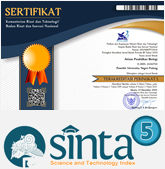Identification of Misconceptions on Material of Food Digestive System in Humans Using Two Tier Multiple Choice Diagnostic Tests at SMPN 15 Padang
Abstract
Misconceptions is a concept that doesn’t suitable with the concept recognized by expert. Misconceptions whom occur in students’ selves prohibit the formed of relation with new concepts and disrupt the realization of learning process. Therefore, misconceptions needs to be known by teacher and folloed up early. The aim of this research is to identify the misconception on the concepts of food digestive system material in humans which experienced by second class at SMP 15 Padang. This research is a descriptive research which conducted at SMP 15 Padang. The populations of this research are 221 students of second class. The sample is 22,5% of 221 members of populations, which is 50 members.the tacking of sampling used simple random sampling technique. The data used are primary data which taking by two tier multiple choice and analyzed through quantitative technique analysis by percentage.
Based on the results of the study, it seen that the highest misconception is the type of food ingredients and its content by 38%, digestive organs (digestive glands and glands) by 49%, the structure and function of the digestive organs by 38%, the relationship between structure and bioprocess in digestive organs by 46.75%, indicator of mechanical and chemical digestion by 50%, disorders / diseases of the digestive system by 49%, and the Thus it can be concluded that there is a misconception in Class VIII students of SMP 15 Padang about the food digestive system material in humans with varying percentages.
Keywords
Full Text:
FullpaperReferences
Adodo. 2013. Effects of Two-Tier Multiple Choice Diagnostic Assesment Item on Students’ Learning Outcome in Basic Science Technology (BST). Academic Journal of Interdisciplinary Studies Published by MCSER-CEMAS-Sapienza University of Rome. Vol 2 No 2. Hlm. 201-210.
Ariandini, D. dkk. 2013. “Identifikasi Miskonsepsi Siswa SMP pada Konsep Fotosintesis Melalui Analisis Gambar”. Skripsi. FMIPA Universitas Pendidikan Indonesia
Arikunto, S. 2009. Dasar-Dasar Evaluasi Pendidikan. Jakarta: Bumi Aksara.
Dahar, Ratna Wilis. 2006. Teori-teori Belajar. Jakarta: Erlangga.
Emriyuni, S. dkk. 2018. Identifikasi Miskonsepsi Materi Transpor Zat pada Mahasiswa Tahun Pertama Menggunakan Teknik Certainty of Response Index (CRI) di Program Studi Pendidikan Biologi UNP. Bioeducation Journal. Vol. 2, No. 1.
Noviana, Mufida, dkk. 2016. “Pengembangan Two-Tier Multiple choice Question disertai Teknik CRI (Certainty Of Response Index) Sebagai Instrumen Diagnostik Miskonsepsi Materi Genetika”. Seminar Nasional Pendidikan dan Saintik. Universitas Muhammadiyah Purwokerto.
Nurracmani, Rivani Dwi. 2017. Identifikasi Miskonsepsi pada Konsep Sistem Pencernaan Makanan pada Manusia dengan Tes Four Tier Multiple Choice. Skripsi. Bandung: UPI.
Sagala, Syaiful. 2012. Konsep dan Makna Pembelajaran. Bandung: Alfabeta.
Sudijono, A. 2011. Pengantar Evaluasi Pendidikan. Jakarta: Rajawali Pers
Tayubi, Yuyu R. 2005. “Identifikasi Miskonsepsi pada Konsep-Konsep Fisika Menggunakan Certainty of Response Index (CRI)”. Mimbar Pendidikan. Vol. 3. No. 24. Hlm. 4-9.
Treagust, David F. 2006. “The Development of a Two-tier Multiple-Choice Diagnostic Instrument for Evaluating Secondary School Students’ Ability to Describe and Explain Chemical Reactions using Multiple Levels of Representation”. International Journal Science Education. 8 (3) 293-307.
Tuysuz, Cengiz. 2009. Development Of Two Tier Diagnostic Instrument And Assess Students’ Understanding in Chemistry. Scientific Research and Essay.Vol. 4 (6).
Wahyuningsih, E. 2016. “Identifikasi Miskonsepsi IPA siswa Kelas V di SD Kanisius Beji Tahun Pelajaran 2015/2016”. Jurnal Pendidikan Guru Sekolah Dasar Edisi 22.
DOI: http://dx.doi.org/10.24036/apb.v4i1.4939
DOI (Fullpaper): http://dx.doi.org/10.24036/apb.v4i1.4939.g2813




